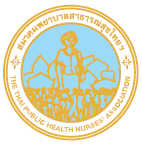การพัฒนาหุ้นส่วนสุขภาพสำหรับผู้เป็นเบาหวานโดยพยาบาลเวชปฏิบัติชุมชน
Keywords:
การพัฒนาหุ้นส่วนสุขภาพ, ผู้เป็นเบาหวาน, พยาบาลเวชปฏิบัติชุมชน, Health partnership development, diabetes patients, community nurse practitionerAbstract
การวิจัยเชิงปฏิบัติการครั้งนี้มีวัตถุประสงค์เพื่อพัฒนาหุ้นส่วนสุขภาพและศึกษาผลการเปลี่ยนแปลงหลังการพัฒนาหุ้นส่วนสุขภาพ กลุ่มเป้าหมายหลัก คือ ผู้เป็นเบาหวานในชุมชนหมู่ 1 ตำบลบางกระเบา อำเภอนครชัยศรี จังหวัดนครปฐม จำนวน 42 คน กลุ่มเป้าหมายรอง ได้แก่ ผู้ดูแล แพทย์ พยาบาลเวชปฏิบัติชุมชน พยาบาล เภสัชกรโภชนากร นักกายภาพบำบัด อาสาสมัครสาธารณสุข จำนวน 27 คน เก็บข้อมูลโดยใช้แบบสอบถามและการสัมภาษณ์ วิเคราะห์ข้อมูลด้วยสถิติไคสแควร์ สัมประสิทธิ์สหสัมพันธ์ของเพียร์สัน การทดสอบทีและการวิเคราะห์เนื้อหา
ผลการวิจัย พบว่า ผู้เป็นเบาหวานส่วนใหญ่เป็นเพศหญิง (ร้อยละ 64.3) จบการศึกษาระดับประถมศึกษา (ร้อยละ 71.4) อาศัยอยู่กับครอบครัว (ร้อยละ 97.6) มีอายุ 65 ปีขึ้นไป (ร้อยละ 66.7) และรับรู้ว่าตนมีโรคแทรกซ้อน จากโรคเบาหวาน (ร้อยละ 69) ซึ่งปัจจัยที่มีผลต่อพฤติกรรรมการดูแลตนเองของผู้เป็นเบาหวานอย่างมีนัยสำคัญทางสถิติ ประกอบด้วย อายุ ระดับการศึกษา ลักษณะครอบครัว และโรคแทรกซ้อนจากเบาหวาน
จากการวิเคราะห์บทบาทหน้าที่หุ้นส่วนแยกได้ 2 ประเด็น คือ 1) การปฏิบัติของบุคลากรสุขภาพในโรงพยาบาลต่อการจัดการสุขภาพผู้เป็นเบาหวาน พบว่า ขาดการเชื่อมประสานบทบาทภายในและระหว่างทีมดูแลผู้ป่วย และ 2) การปฏิบัติบทบาทหน้าที่ของผู้ดูแลต่อผู้เป็นเบาหวาน พบว่าขาดความร่วมมือในการดูแลผู้เป็นเบาหวานอย่างต่อเนื่อง
การพัฒนาหุ้นส่วนสุขภาพในชุมชนสำหรับผู้เป็นเบาหวานประกอบด้วย 3 ขั้นตอน คือ 1) ร่วมมือกันสร้างความเป็นหุ้นส่วนสุขภาพด้วยการประชุมย่อยและประชุมร่วมทั้งทางการและไม่ทางการ 2) ร่วมกันทบทวนกำหนดบทบาทหน้าที่ใหม่โดยพยาบาลเน้นบทบาทผู้ให้คำปรึกษา ผู้จัดการเฉพาะราย ผู้ประสานงาน วางแผนจำหน่ายร่วมกับทีมสหวิชาชีพ ส่วนผู้เป็นเบาหวานและผู้ดูแลมาร่วมเป็นสมาชิกทีม และ อสม. ทำหน้าที่จิตอาสาประจำครัวเรือน 3) การดำเนินกิจกรรมและประเมินผลความก้าวหน้าไปสู่เป้าหมาย 5 ส่วน คือ หุ้นส่วนร่วมวางแผนเฉพาะรายก่อนผู้เป็นเบาหวานกลับบ้าน กลุ่มเพื่อนช่วยเพื่อนในโรงพยาบาล หุ้นส่วนร่วมเยี่ยมบ้าน สร้างเครือข่ายเยี่ยมบ้านและหุ้นส่วนติดตามผล
หลังการพัฒนาหุ้นส่วนสุขภาพพบว่าคะแนนเฉลี่ยเกี่ยวกับความรู้เรื่องโรคและพฤติกรรมการดูแลตนเองของผู้เป็นเบาหวานสูงขึ้นอย่างมีนัยสำคัญทางสถิติ พยาบาลเวชปฏิบัติชุมชนสร้างมูลค่าเพิ่มให้บทบาทของตนเองด้วยการให้ผู้เป็นเบาหวานเลือกและตัดสินใจร่วมกับทีมสุขภาพมากขึ้น หุ้นส่วนทุกฝ่ายทั้งในโรงพยาบาลและในชุมชนร่วมประสานและดำเนินกิจกรรมตามที่วางแผนไว้จนเกิดนวัตกรรมท้องถิ่น คือ ออกกำลังกายวิถีไทย สูตรอาหารบางกระเบาและดูแลเท้าวิถีไทย ผลวิจัยมีข้อเสนอแนะว่าให้พัฒนาเป็นต้นแบบของการปฏิบัติ วางระบบการพัฒนาให้ครอบคลุมผู้เกี่ยวข้องให้มากขึ้น มีการประเมินผลการใช้รูปแบบระยะยาวและขยายการศึกษาปัจจัยที่มีผลต่อการดูแลตนเองของผู้เป็นเบาหวานให้มากขึ้นเพื่อการดูแลแบบองค์รวมต่อไป
Health Partnership Development for Diabetes Clients by Community Nurse Practitioner
The purpose of this action research was aimed to develop health partnership and to examine what changes occurred after having developed health partnership. Major perspectives samples included 42 diabetes patients in Moo.1, Bangkabao, Nakhonchaisri, Nakhonpathom, and minor perspective samples included 27 patient caregivers, physicians, nurse practitioners, nurses, pharmaceutics, nutritionists, physical therapist, and health volunteers. Data collection was carried out using the questionnaires and interview. Data analysis was performed using Chi-squares, Pearson’s coefficient, t-test, and content analysis.
The results showed that diabetes patients mainly were female (64.3%), primary education background (71.4%), staying with family (97.6%), and aged 65 years or higher (66.7%), perception of diabetes complications (69%). The predominant factors influencing the diabetes patients’ healthcare included age, educational background, nature of family, and complications.
Analysis of partnership role could be described into two parts, firstly, performance of health personnel in the hospital for diabetes patient’s health management, and secondly, performance of caregivers. In the light of health personnel’s performance, the finding indicated the lack of internal coordination among caregiver teams while it indicated the lack of continuous taking care of the diabetes patients for caregiver’s performance.
The processes of the development of health partnership for diabetes patients in community consisted of three steps. Firstly, collaborative improvement on health partnership through minor and general meeting informally and formally, secondly, collaborative reviewing and reassignment of role and responsibility; namely nurse role were focused as counselor, individual manager, coordinator, plan-maker in collaboration with multidisciplinary team in discharge of the patients. The diabetes patients and caregiver were team members and volunteer health personnel serves as household volunteer, and lastly, activities and health assessment to achieve five major areas; including, individual planning partners before diabetes patients were discharged and returned home, hospital peer group, home visitors, home visitor network, and follow-up partnership.
The results showed that knowledge about diabetes and self-caring behaviors in diabetes patient post partnership development was higher significantly. The community nurse practitioners added value in their role by encouraging the diabetes patients to decide along with health teams more increasingly. All concerned partnerships in the hospital and community coordinated to carry the planned activities to bring for the local innovation which included exercise and food recipes in Thai way of living. The results of this study suggested that development protocol in practice should be developed. Development plan should cover those concerned persons more increasingly. Long term assessment and further examination of factors influencing the diabetes patients’ self-caring behavior as whole should be performed.
Downloads
How to Cite
Issue
Section
License
บทความที่ตีพิมพ์และแผนภูมิรูปภาพถือเป็นลิขสิทธิ์ของวารสารพยาบาลสาธารณสุข (Thai Public Health Nurses Association)






